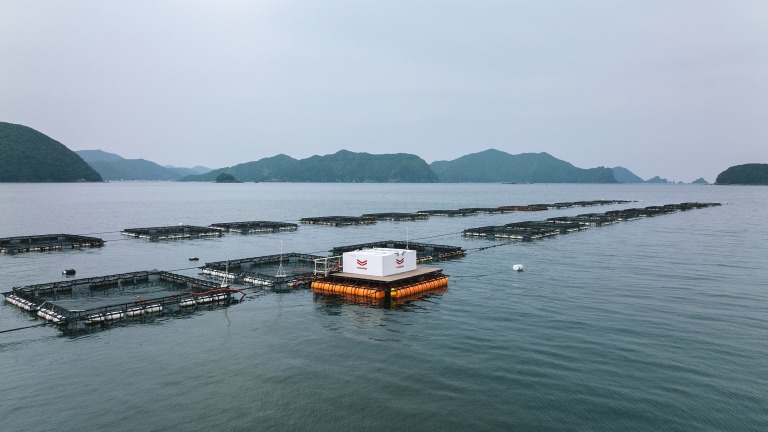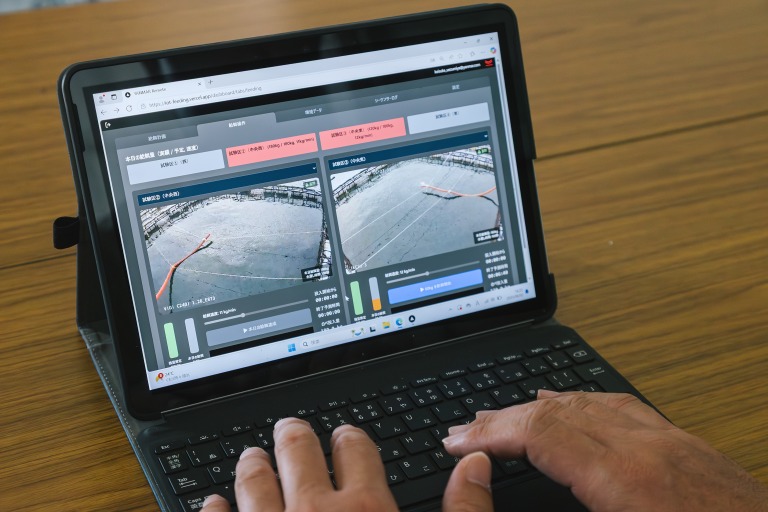F&LC Joins Joint Demonstration Test of Remote Automated Feeding System Toward Sustainable Fisheries

FOOD & LIFE COMPANIES Co., Ltd. (hereinafter referred to as F&LC), Owasebussan Co., Ltd. (hereinafter referred to as Owasebussan), and Yanmar Holdings Co., Ltd. (hereinafter referred to as Yanmar HD) have begun full-scale joint demonstration tests of a remote automated feeding system for yellowtail aquaculture in June 2025, with the aim of realizing a sustainable aquaculture industry.
In recent years, the importance of aquaculture as a marine resource that does not depend on natural sources has increased, but there are also issues such as labor shortages, rising feeding costs, and the impact of rising seawater temperatures in summer on catches. The remote automated feeding system developed by Yanmar HD incorporates a mixed feeding technology of seawater and feed that can reduce energy costs compared to previous systems, and is also designed for future application to submerged fish cages. First, demonstration tests will be conducted in an offshore fish cage at Owasebussan’s yellowtail farm (Owase City, Mie Prefecture), which produces approximately 600,000 fish per year, and then application to submerged fish cages will be promoted.
In addition, following taste analysis by F&LC, the yellowtail farmed in this demonstration project is scheduled to be sold at some of the Sushiro stores operated by F&LC in 2026.
■About the joint demonstration test
1. Demonstration test overview
Location: Owasebussan Co., Ltd. Owase Aquaculture Farm (Owase City, Mie Prefecture)
Period: June 2025 to January 2026 (planned)
Target: Yellowtail, about 14,000 fish
2. Each companyrole
FOOD & LIFE COMPANIES Inc.
Quality evaluation of farmed yellowtail using F&LC standards
Owasebussan Co., Ltd.
Provision of aquaculture sites, raising of yellowtail, and technical support and evaluation of the work carried out
Yanmar Holdings Co., Ltd.
Development and operation of a remote automated feeding system, acquisition and analysis of demonstration data
3. Goals for the joint demonstration test
F&LC’s vision—“Discovering new tastiness, Sharing moments of joy.”We believe that “sustainable procurement of seafood” is important to continue delivering safe and delicious food to our customers. To achieve this, we are working to build a foundation for stable procurement by working with aquaculture operators who can ensure planned procurement while also using appropriate wild fish. We also aim to procure sustainable seafood resources by researching seafood that responds to environmental changes and improving productivity at aquaculture sites through collaboration with companies.
Owasebussan works to consistently supply high-quality farmed fish that meet market demands despite environmental fluctuations. Through collaborations with universities, it is developing advanced aquaculture technologies tailored to the specific characteristics of local marine environments.
The Yanmar Group is committed to realizing a sustainable society, A SUSTAINABLE FUTURE, by enabling a safe and reliable food supply. In the fisheries sector, the group promotes a shift from wild-catch to aquaculture and provides ocean solutions to minimize resource waste and support sustainable fishing practices.
The aim is to create a sustainable fisheries management model through comprehensive demonstration testing from upstream to downstream, bringing together the Yanmar Group’s aquaculture-related technology, Owasebussan’s aquaculture production system, and F&LC’s knowledge of the fisheries industry.
4. Aquaculture-related technologies
The Yanmar Group has aquaculture-related technologies, such as the technology to automatically count fish and their weight using image recognition technology based on data from fish shadows captured by special-purpose underwater cameras, as well as technology to produce triploid oyster seedlings that enable stable shipments.
In this demonstration test, a remote automated feeding system was developed using remote control technology used for agricultural and construction machinery that can be controlled from a remote location. The ergonomic design adopted an HMI (Human Machine Interface) that allows the status of multiple fish cages to be checked at a glance, making it possible to efficiently feed multiple fish cages at the same time. Since the feeding status can be checked from a remote location, feeding efficiency can be improved and the amount of work can be reduced. In addition, with the price of feed continuing to rise due to the social situation, the seawater and feed mixed feeding technology reduces the breakage and chipping of feed during feeding, making efficient feeding possible and is expected to improve feed efficiency.



-
2025.08.21
OverseasSustainabilitySUSHI QUEST, A Fun and Educational Game for Learning About Aquatic Resource Challenges and Sustainable Fishing TechnologyReleased through Digiro at SUSHIRO To The Future: Expo Edition
-
2025.07.23
ManagementSustainabilityF&LC selected for inclusion in the FTSE Blossom Japan Sector Relative Index for the first time
-
2025.07.09
OverseasSustainabilitySUSHIRO To The Future: Expo EditionNew Sustainable Sushi Featuring Seafood Species Adaptable to Rising Ocean TemperaturesAvailable Starting Wednesday, July 2
-
2025.04.23
SustainabilityCSRAkindo Sushiro Receives Letter of Appreciation from Asahi Town, Toyama Prefecture for Corporate Version of Furusato Nozei (Hometown Tax Donation Program)
-
2025.04.14
ManagementSustainabilityAnnouncement of closing all SUSHIRO stores in Japan for two days on May 13th (Tue) and 14th (Wed) – As part of efforts to create a more comfortable working environment
